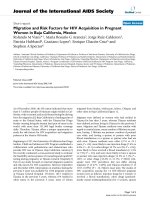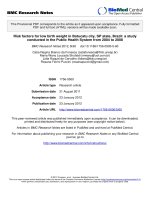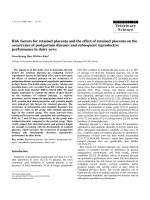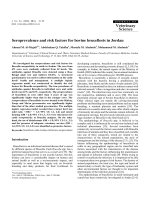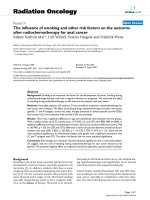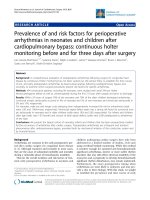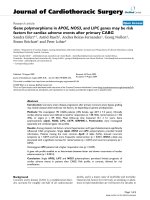Socio-demographic, environmental and caring risk factors for childhood drowning deaths in Bangladesh
Bạn đang xem bản rút gọn của tài liệu. Xem và tải ngay bản đầy đủ của tài liệu tại đây (366.19 KB, 6 trang )
Hossain et al. BMC Pediatrics (2015) 15:114
DOI 10.1186/s12887-015-0431-7
RESEARCH ARTICLE
Open Access
Socio-demographic, environmental and
caring risk factors for childhood drowning
deaths in Bangladesh
Mosharaf Hossain1*, Kulanthayan K. C. Mani1*, Sherina Mohd Sidik2, K. S. Hayati1 and A. K. M. Fazlur Rahman3
Abstract
Background: Drowning contributes to incapacity and early death in many countries. In low- and middle-income
countries, children are the most susceptible to fatalities. Over 50 % of the global drowning deaths occur among
children aged under 15 years old with children aged between 1 and 4 years of age being most at risk. In
Bangladesh, drowning rates are 10 to 20 times more than those in other developing countries. The object of this
study is to determine the socio-demographic, environmental and caring hazard issues for child drowning in
Bangladesh.
Methods: A case–control study was conducted, with data collected from the Bangladesh Health and Injury Survey
(BHIS) to identify the social-demographic and environmental factors associated with childhood drowning. The
participants represented 171,366 households from seven divisions of Bangladesh—Dhaka, Rajshahi, Chittagong,
Barisal, Sylhet, Khulna and Rangpur. The survey was conducted between January and December of 2003. A total
of 141 children drowning were identified in the year preceding the survey. Data were analysed using descriptive
statistics and logistic regression analysis. The odds ratios with 95 % CI intervals were estimated for various
associated factors for child drowning deaths.
Results: In Bangladesh, in 2003, the incidence of drowning deaths was 104.8 per 100,000 among those aged less
than 5 years; 168.7 per 100,000 in rural areas; male 32.4 per 100,000; 112.7 per 100,000 between 10:00 a.m. and
2:00 p.m.; and cannot swim 134.9 per 100,000. The socio-demographic danger factors for child drowning deaths
were: being male (OR = 1.45, 95 % CI = 1.34–1.78), aged less than 5 years (OR = 2.89, 95 % CI = 1.89–3.11), urban
areas (OR = 0.67, 95 % CI = 0.67–1.87), and mother being illiterate (OR = 1.69, 95 % CI = 1.01–2.81). Significant
environmental and caring factors included mother/caregiver not being the accompanying person (OR = 25.4,
95 % CI = 14.4–45.3) and children cannot swim (OR = 4.5, 95 % CI = 1.25–19.4).
Conclusion: Drowning is the single largest reason for the mortality of children aged less than five years. There is a
need to educate Bangladeshi parents and encourage behavioural change concerning supervision. The Government
should use mass media to raise awareness about drowning among the community with a focus on rural areas.
Policies should focus on increasing supervision by mothers/care persons, swimming skills, and should target
illiterate mothers. Therefore, there is an immediate need for the Bangladeshi Government to address the problem
of drowning.
Keywords: Social-demographic, Environmental and caring, Risk factors, Drowning, Bangladesh
* Correspondence: ;
1
Department of Community Health, Faculty of Medicine and Health Science,
University Putra Malaysia, Serdang, Malaysia
Full list of author information is available at the end of the article
© 2015 Hossain et al. Open Access This article is distributed under the terms of the Creative Commons Attribution 4.0
International License ( which permits unrestricted use, distribution, and
reproduction in any medium, provided you give appropriate credit to the original author(s) and the source, provide a link to
the Creative Commons license, and indicate if changes were made. The Creative Commons Public Domain Dedication waiver
( applies to the data made available in this article, unless otherwise stated.
Hossain et al. BMC Pediatrics (2015) 15:114
Background
The classification of drowning is that accepted by the
first world assembly on drowning: the process of experiencing respiratory impairment from submersion or
immersion in liquid; outcomes are classified as mortality,
illness and no morbidity [1]. Drowning is the third highest reason for accidental injury globally, and 7 % of all
injuries connected with death worldwide are caused by
drowning [2]. An estimated per year 372,000 drowning
deaths occurred in the world [2]. Among children,
drowning accounts for a higher mortality rate than any
other type of child injury, and the drowning rate in Asia
is 20 times higher than in developed countries [3]. Who
is at risk? Children under 5 years of age, males, people
exposed to water, those with low socio-economic status
or lacking education, and infants left unsupervised [2].
Drowning is the single highest cause of mortality after
infancy: 50 % of drownings occur between the ages of 0
and 4 years; 60 % of drownings occur between 9:00 a.m.
and 1:00 p.m.; the majority (80 %) of drowning mortality
happens in natural water bodies like millponds and
channels; the maximum (80 %) occur within 20 cm of
the family; and children of large households are more in
danger of drowning than those from small households
[4]. In Bangladesh, every half an hour a child drowns,
this is 50 drowning deaths a day and 18,225 drowning
deaths per annum [4].
Bangladesh is a mainly pastoral low-income country
with the majority of homes situated near bodies of water
[5]. Many children are unable to swim and families are
large, making adult supervision difficult [6]. These issues
contribute to make drowning the foremost reason of
child mortality after infancy in Bangladesh. The drowning death rate, 28.6 per 100,000 child-years, is 22 times
larger than in the Americas [5–10]. The virtual death
due to underwater deaths in children was about 28 % for
common child death [11]. Ponds, ditches, buckets and
drums were the most common spaces for drowning, and
over 40 % happened in millponds [11]. The child’s gender, mother’s age and literacy, family income and ownership of agricultural land by the families were found to be
risk factors [11]. The occurrence of drowning among
children aged under five years was 157 per 100,000
children-year [12]. The highest rate by single year of age
and gender was 328.1 per 100,000 (95 % CI 254.8–421.7)
for 1 year old male children [13]. The proportional mortality due to drowning in the children was 27.9 % for
overall child mortality. The risk factors were mother’s
age, literacy, family income. Male children from deprived
household were at greatest risk of drowning in rural
Bangladesh [14].
In 2015, in Bangladesh, children aged between 1 and
17 years injury was the main reason of death and Drowning
is the highest [15]. The significant advancements in the
Page 2 of 6
decrease of child deaths from communicable infection in
Bangladesh over the last two years has meant that injuries
represent a greater danger to children [15]. Although the
rates of drowning have been constant since the 1980s,
drowning as a percentage of all types of mortality in children aged 1–4 has increased from 9 % in 1983 to 59 % in
2003 [15]. The purpose of the Millennium Development
Goal (MDG 4) is to reduce child deaths. The Bangladesh
Government target is to reduce the deaths of children
under five years of age by two-thirds, and, overall, by 48 per
1000 by 2015 [15]. The Government expends a lot of
money on HIV/AIDS through advertisements on the TV,
radio and billboards, as well as in newspapers, but less attention is paid to the problem of drowning, which is one of
the significant issues in the society. The objective of this
study is to define the socio-demographic, environmental
and caring risk factors concerning drowning in Bangladesh.
Methods
Study design
A case–control study was conducted as a separate component of the Bangladesh Health and Injury Survey (BHIS)
to determine the socio-demographic, environmental and
caring risk factors on drowning in Bangladesh.
Sample size
The Bangladesh Health and Injury Survey (BHIS) is the
leading injury investigation directed at the public level in
a developing country, with a trial scope of 171,366
homes and a total piloted people of 819,429. The investigation was piloted between 1 January and 30 December
2003, and included all age groups; 43 % (351,651) of the
surveyed population were children, and data for children
under five were collected from parents. Children were
defined in this report as infants and children of all ages,
up to their 18th birthday (0–17 years old). A total of 141
child drowning deaths was identified in the year preceding
the survey. When a child drowning death was discovered
during the interview process, controls were selected and
interviews conducted by the same interviewer who identified the case.
Data collection
The field activities for data collection were conducted
between January and December 2003 by BHIS. The
BHIS is the main injury investigation directed at the
public level in a developing country.
Sampling technique
Twelve out of 64 districts were randomly selected for the
survey in Bangladesh. In each region, one upazila (rural
sub-region) was randomly nominated. In each upazila,
two unions (lowermost governmental parts collected of
almost 20000 persons) were nominated randomly. Overall,
Hossain et al. BMC Pediatrics (2015) 15:114
24 unions were nominated for the study. All families in
the union were included in the investigation.
Page 3 of 6
Table 1 Child drowning deaths rates and near drowning rates
by social-demographic, environmental and caring factors
Factors
Respondents
Mothers (mothers were surveyed on behalf of their children) were preferred as the main respondent. When a
mother was unavailable, the most well-informed member
(uncle, grandfather or grandmother) of the family members
present at the time of conversation was the participant.
Rates (Per 100000)
Child drowning deaths rates by age (Years)
0–4
104.8
5–9
26.2
10–14
2.9
15–17
2.0
Child near drowning rates by age (Years)
Cases
0–4
443.7
Drowning deaths between 1 January and December 2003.
5–9
73.9
10–14
13.6
15–17
4.8
Controls
Age and sex were matched per one child drowning to at
least two living children.
Data analysis
The numerical examination of the results was slow using
the IBM SPSS statistics Version 21. Data were analysed
using descriptive statistics and logistic regression analysis.
Logistic regression was used to determine the danger issues with children drowning mortality and respondent’s
age, place of home, gender, mother’s learning level, father’s
educational level, mother’s occupation, father’s occupation, number of children, accompanying person and
swimming ability. The 95 % CI (Confidence Interval) level
was measured significant at a P value of 0.05. The
dependent variable was used the two dichotomous: Y = 1
if have child drowning deaths and Y = 0, otherwise.
Respondent’s age, place of residence, gender, mother’s
educational level, father’s educational level, mother’s
occupation, father’s occupation, number of children,
accompanying person and swimming ability were
measured as forecaster variables in this classical.
Ethical issues
Written or verbal knowledgeable agreement was obtained
from all the respondents before collecting data. The respondents were assured that the data would only be used
for research purposes and that all answers would be
treated as confidential. Permission for this study was obtained from the Ethical Review Committee of the Ministry
of Health and Family Welfare, Dhaka, Bangladesh.
Results
Drowning deaths peaked in the 0–4 age group (104.8
per 100,000) and then rapidly declined as age increased:
5–9 years 26.2 per 100,000, 10–14 years 2.9 per 100,000
and 15–17 years 2 per 100,000. The near drowning was
highest the children aged 0–4 years 443.7 per 100,000
and then decreased near drowning with increased age.
Significantly different drowning rates were observed
among different age groups of rural and urban children
Place of residence
Rural
168.7
Urban
33.4
Gender
Male
32.4
Female
24.8
Time when children to drowning deaths
10:00 AM–2:00 PM
112.7
Others time
34.6
Accompanying person
Mother/Caregiver
45.9
Others
88.7
Swimming ability
Can swim
5.7
Cannot swim
134.9
in Bangladesh. Urban areas have low rates, whereas
those in rural areas are higher. Children under five years
in pastoral areas had the highest drowning rate (136.9/
100,000). The age groups 10–14 and 15–17 did not appear as the drowning deaths in these age groups were
too low to enable a meaningful comparison between
urban and rural distributions. There is a significant
Table 2 Child drowning deaths rates (per 100000) in Bangladesh
Factors
Rates (Per 100000)
Age (Years)
Urban
Rural
0–4
33.1
5–9
10.8
38.9
10–17
2.9
10.8
Age (Years)
158.7
Male
Female
0–4
113.9
95.2
5–9
31.1
21.0
10–17
9.6
1.0
Hossain et al. BMC Pediatrics (2015) 15:114
Page 4 of 6
Table 3 Risk factors between social-demographic, environmental and caring factors with childhood drowning deaths, BHIS, 2005
Factors
Cases
Number
Control
Odd ratio
Percentage
Number
Percentage
95 % CI
Children’s age (Years)
0–4
105
74.6
145
42.7
2.89*
1.89–3.11
5–9
25
17.7
102
30.1
1.66*
1.44–1.98
10–17 (RC)
11
7.7
92
27.2
1.00
……….
Male
80
56.7
178
52.5
1.45*
1.34–1.78
Female (RC)
61
43.3
161
47.5
1.00
………
Urban
39
27.6
198
58.4
0.67*
0.34–1.87
Rural (RC)
102
72.4
141
41.6
1.00
……..
Illiterate
70
49.6
135
39.8
1.69*
1.01–2.81
Primary
43
30.5
113
33.3
1.24
0.71–2.14
Secondary + (RC)
28
19.8
91
26.8
1.00
……….
Illiterate
64
45.4
139
41.0
1.10
0.68–1.77
Primary
30
21.3
88
26.0
0.81
0.46–1.46
Secondary + (RC)
47
33.4
112
33.0
1.00
……..
Home maker
135
95.7
326
96.2
1.00
………
Other than housewife
6
4.3
13
3.8
1.11
0.37–3.23
Cultivator (RC)
98
69.5
221
65.2
1.00
………
Other occupation
43
30.5
118
34.8
0.82
0.53–1.28
25–29 years (RC)
47
33.3
117
34.5
1.00
………..
Less than 20 years
4
2.8
9
2.7
1.11
0.27–4.20
Gender
Place of residence
Mothers Education
Fathers education
Mothers occupation
Fathers occupation
Mothers age
20–24 years
21
14.9
76
22.4
0.69
0.37–1.29
30 years+
69
48.9
137
40.4
1.25
0.78–2.01
45
31.9
137
40.4
1.00
…….
Number in children
Less than 3 (RC)
3–4
46
32.6
124
36.6
1.13
0.68–1.87
5 & more
50
35.5
78
23.0
1.95*
1.2–3.30
21
14.9
276
81.7
1.00
……..
62
18.3
*
25.4
14.4–45.3
26
7.7
1.00
…….
Accompanying person
Mother/Caregiver (RC)
Others
Swimming ability
Can swim (RC)
Cannot swim
Model summary:
2 log likelihood: 242.922
120
85.1
142
42.1
*
4.5
1.25–19.4
Hossain et al. BMC Pediatrics (2015) 15:114
Page 5 of 6
Table 3 Risk factors between social-demographic, environmental and caring factors with childhood drowning deaths, BHIS, 2005
(Continued)
Cox & Snell R Square: 0.51
Negelikereke R: 0.60
Model Chi-Square: 8.019
RC = Reference category, *p = Level of significant, Source: BHIS, 2005
dissimilarity in the rate between males and females in the
same age group. Males are at greater risk of drowning. The
drowning death rate for children 1–17 years was 28.6/
100,000, of which males were 32.4/100,000 and females
24.8/100,000. Almost all (97 %) drownings occurred during
the hours of daylight between 10:00 a.m. and 2:00 p.m.
Other factors include the swimming ability of children
aged over 4 years who drowned and the person accompanying the children prior to drowning (Tables 1 and 2).
Child age is the major risk factor for drowning deaths.
Children aged 0–4 years were at 2.89 (OR = 2.89, 95 %
CI = 1.89–3.11) times higher risk of drowning compared
to children aged 10–17 (reference group) years, while
children aged 5–9 years were at 1.66 (OR = 1.66, 95 %
CI = 1.44–1.98) times higher risk of drowning deaths
than the reference group. Males were at 1.45 times increased risk of dying from drowning compared to females.
Place of residence is also a risk factor for childhood
drowning deaths. For urban children it is 0.67 (OR = 0.67,
95 % CI = 0.34–1.87) times the risk of that of rural children. The results indicated that males are at 1.45 times
higher risk than females (OR = 1.45, 95 % CI = 1.34–1.78).
The results showed that having knowledge and awareness
have a statistically significant effect on drowning deaths.
The proportion of illiterate mothers in child drowning
cases is 0.34, while the proportion of educated mothers in
child drowning cases is 0.20. A child with an illiterate
mother has a 1.7 (OR = 1.7, 95 % CI = 1.01–2.81) increased risk of drowning compared to a child whose
mother has secondary education. A child of a mother who
has five or more children in the family is 1.95 times more
risk of drowning than a child of a mother who has less
than 3 (OR = 1.95, 95 % CI = 1.2–3.3) children. When
children drowned the accompanying persons was alone
(OR = 25.4, 95 % CI = 14.4–45.3) 25 times risk for
drowning to compare the childrens accompanying persons was others relative such as grandmother, grandfather, uncle, etc. Absence of swimming skills (for
children 5–17 years) was associated with childhood
drowning deaths and children who cannot swim are
4.5 times more at risk than children who can swim
(OR = 4.5, 95 % CI = 1.25–19.4) (Table 3).
Discussion
Bangladesh has made great progress in addressing the issue
of communicable diseases, which affects the mortality of
infants and children under-five. Age is a major issue in
terms of drowning mortality. The highest rate of drowning
deaths was identified in the under five year age group
(104.8 per 100,000 for fatal and also 443.7 per 100,000 for
non-fatal). The age shape of drowning deaths was identical
that, only the rates drowning deaths were several times
higher (118/100,000 near drowning; 28.6/100,000 drowning) among children aged 1–17 years [16]. In Bangladesh
the mean percentage of drowning deaths for all causes of
injury deaths was 28 % [17]. The maximum drowning
deaths were between male was 32.4 per 100,000 and 24.8
per 100,000 for female. The mother’s lack of education, as
well as infants left alone, children under 5 years of age, especially males, are the factors that represent the greatest
risk from drowning; this is consistent with other studies
[3]. The drowning rate was highest for those younger than
5 years old, which is consistent with drowning data from
other parts of the world [18, 19]. However, males aged
65 years and older had higher rates than females in
Australia [20], while another study showed that, in
Australia, 76.4 drowning deaths were male, with children
aged under five years having the highest rate (2.63 per
100,000 persons) [21]. However, in Bangladesh, underwater
deaths is the single highest cause of death after infancy;
50 % of drowning deaths occur between the ages of 0 and
4 years [4]. The lack of swimming ability was the highest
cause of drowning among the children.
Males had greater underwater death rates compared to
females. Our outcomes have similarity with these studies. In New Zealand, 76 % of unintentional drownings
involved males [22]. The highest number of underwater
deaths occurred among males in Louisiana with 84 %
[23]. An assessment of Peden and McGee [19] exposed
that males had a higher death rate due to drowning
compared to females for all age groups. Lindholm and
Steensberg [24] stated that, in Denmark, males were involved in 72.5 % of underwater deaths. The underwater
deaths involving males in Iran was 87 % and the ratio
of male–female mortality rate was 6.5:1. The outcome
of Ma et al. [25] showed that boys were at greater
danger of drowning than girls in China. In the United
States, the percentage of mortality was meaningfully
superior among males than among females. Overall,
males are more likely to drown than females. The outcomes showed that males were particularly at danger of
drowning in Bangladesh.
Hossain et al. BMC Pediatrics (2015) 15:114
Drowning prevention programmes should include active
prevention, such as establishing child care at home, especially for children under five years old; increase knowledge
and awareness about childhood drowning, especially
among rural parents; aquatic protection supervision by
close relative; aquatic security teaching; drowning education for children in every school; and fixing of cautionary
symbols in dangerous areas in Bangladesh. The current
research studied drowning deaths in Bangladesh based on
the available data in terms of gender and age group. Study
limitations include the fact that the majority drowning
cases go unrecorded. The next restriction is the absence
of evidence from hospital and clinics, and the final limitation is information bias, as original research is costly and
this study was dependent on sources of data from others,
such as police data and post-mortem data.
Conclusion
Age is the main contributory factor for drowning deaths.
Other factors include gender (male), place of residence
(rural area children), time of day (10:00 AM-2:00 PM),
and parents educational level. The lack of attention of
parents concerning their children and the lack of proper
supervision of children swimming of (five years and
over) contribute to the high number of drownings. Most
of the Bangladeshi community has open ponds/rivers
without boundaries and protection, which allows free access for drowning. Due to the magnitude of the drowning problem the government should develop and deliver
an integrated programme via the media, education,
ponds should be fenced, and skills should be developed
to reduce drowning. Policies should focus on increasing
supervision by mothers/care persons, swimming skills,
and should target illiterate mothers. Therefore, there is
an immediate need for the Bangladeshi Government to
address the drowning problem.
Competing interests
The authors declare that they have no competing interests.
Authors’ contributions
MMH made substantial contributions to the study design, acquisition and
analysis of data, as well as intellectual content. KKCM contributed to drafting
the manuscript or revising it critically for important intellectual content. SMS,
KSH and AKMFR contributed to final approval of the version to be published.
The final manuscript was approved by all authors.
Acknowledgements
The authors wish to acknowledge and express their gratitude for the
professional work of the Bangladesh Health and Injury Survey, which
administered this survey and without which this work would not
have been possible.
Author details
1
Department of Community Health, Faculty of Medicine and Health Science,
University Putra Malaysia, Serdang, Malaysia. 2Department of Psychiatry,
Faculty of Medicine and Health Science, University Putra Malaysia, Serdang,
Malaysia. 3Department of Epidemiology, Bangladesh University of Health
Sciences, Dhaka, Bangladesh.
Page 6 of 6
Received: 7 April 2014 Accepted: 21 August 2015
References
1. Van Beeck EF, Branche CM, Szpilman D, Modell JH, Bierens JJLM. A new
definition of drowning: towards documentation and prevention of a global
public health problem. Bulletin of the World Health Organization. 2005;83:853–6.
2. WHO. Burden of disease: Deaths estimates for 2008 by cause for WHO
member states, health statistics and health information systems- Disease
and injury country estimates. Geneva: World Health Organization; 2012.
3. WHO. Global report on drowning: preventing a leading killer. Geneva: World
Health Organization; 2014.
4. IDRC. International Drowning Research Centre. 2013. Dhaka:
5. Peden M, Oyegbite K, Ozanne-Smith J, Hyder AA. World report on child
Injury prevention, summary. Geneva: World Health Organization; 2008.
6. Rahman A, Mashreky SR, Chowdhury SM, Giashuddin MS, Uhaa IJ, Shafinaz
S, et al. Analysis of the childhood fatal drowning situation in Bangladesh:
exploring prevention measures for low-income countries. Injury Prevention.
2009;15(2):75–9.
7. Blum LS, Khan R, Hyder AA, Shahanaj S, El Arifeen S, Baqui A. Childhood
drowning in Matlab, Bangladesh: an in-depth exploration of community
perceptions and practices. Social Science Medicine. 2009;68(9):1720–7.
8. Brenner RA, Taneja GS, Haynie DL, Trumble AC, Qian C, Klinger RM, et al.
Association between swimming lessons and drowning in childhood: a
case–control study. Arch Paediatric Adolescent Medicine. 2009;163(3):203–10.
9. Hyder AA, Lunnen J. Reduction of childhood mortality through millennium
development goal 4. BMJ. 2011;342:357.
10. Bhutta ZA, Darmstadt GL, Hasan BS, Haws RA. Community-based
interventions for improving perinatal and neonatal health outcomes in
developing countries: a review of the evidence. BMC Paediatrics.
2005;115(2):519–617.
11. Rahman A. A Community Based Child Drowning Prevention Programme in
Bangladesh: a model for low income countries. Thesis for doctoral Degree
(Ph.D). Stockholm: Department of Public Health Sciences, Division of Social
Medicine Karolinska Institutet; 2010.
12. Rahman A, Giashuddin SM, Svanström L, Rahman F. Drowning – a major
but neglected child health problem in rural Bangladesh: implications for
low income countries. International Journal of Injury Control and Safety
Promotion. 2006;13(2):101–5.
13. Becker S, Weng S. Seasonal patterns of deaths in Matlab, Bangladesh.
International Journal of Epidemiology. 2005;27:814–23.
14. Siddique AK, Baqui AH, Eusof A, Zaman K. Floods in Bangladesh: pattern of
illness and causes of death. J Diarrhoeal Disease Research. 1991;9:310–4.
15. MHFW. Ministry of Health and Family Welfare. Dhaka: Government of the
People’s Republic of Bangladesh; 2013.
16. Child Drowning in Bangladesh. Fact Sheet. Dhaka: International Drowning
Research Centre; 2008.
17. Rahman A, Rahman AKMF, Shafinaz S and Linnan M. Bangladesh Health and
Injury Survey: Report on Children. Dhaka: DGHS, ICMH, UNICEF, TASC; 2005.
18. Ahmed MK, Rahman M, Ginneken JV. Epidemiology of child deaths due to
drowning in Matlab, Bangladesh. International Journal of Epidemiology.
1999;28:306–11.
19. Peden MM, McGee K. The epidemiology of drowning worldwide.
International Journal of Injury Control Safety Promotion. 2003;10:195–9.
20. Mitchell R, Williamson AM, Olivier J. Estimates of drowning morbidity and
mortality adjusted for exposure to risk. Injury Prevention. 2010;16:261–6.
21. Franklin RC, Scarr JP, Pearn JH. Reducing drowning deaths: The continued
challenge of immersion fatalities in Australia. Med J Aust. 2010;192(3):123–6.
22. Langley JD, Warner M, Smith GS, Wright C. Drowning-related deaths in New
Zealand, 1980–94. Australia N Z J Public Health. 2001;25:451–7.
23. Kohn M, Duthu R, Flood H, Hall G, Wiley G, Benson KH. Drowning—Louisiana,
1998. JAMA. 2001;286:913–4.
24. Lindholm P, Steensberg J. Epidemiology of unintentional drowning and
near-drowning in Denmark in 1995. Injury Prevention. 2000;6:29–31.
25. Ma WJ, Nie SP, Xu HF, Xu YJ, Song XL, Guo QZ, et al. An analysis of risk
factors of non-fatal drowning among children in rural areas of Guangdong
Province, China: a case–control study. BMC Public Health. 2010;10:156.


